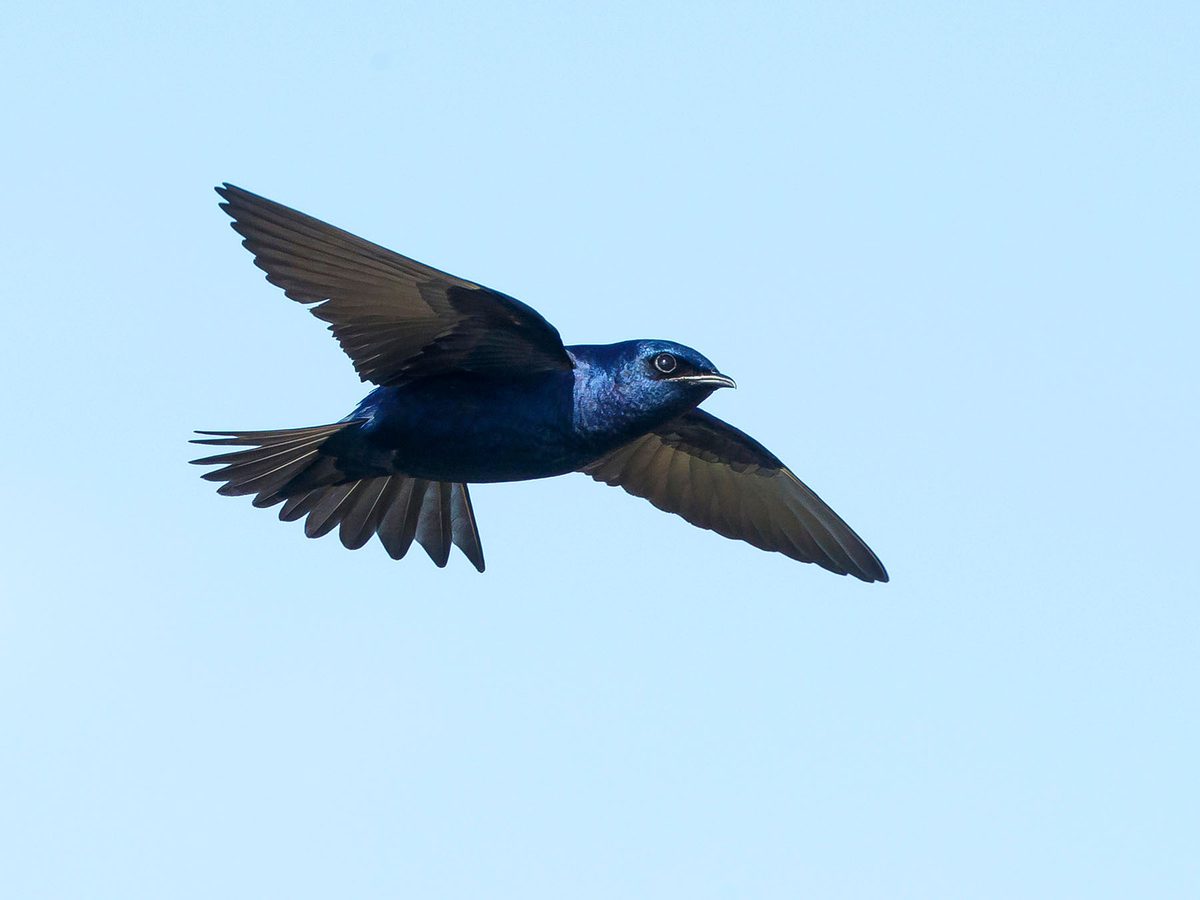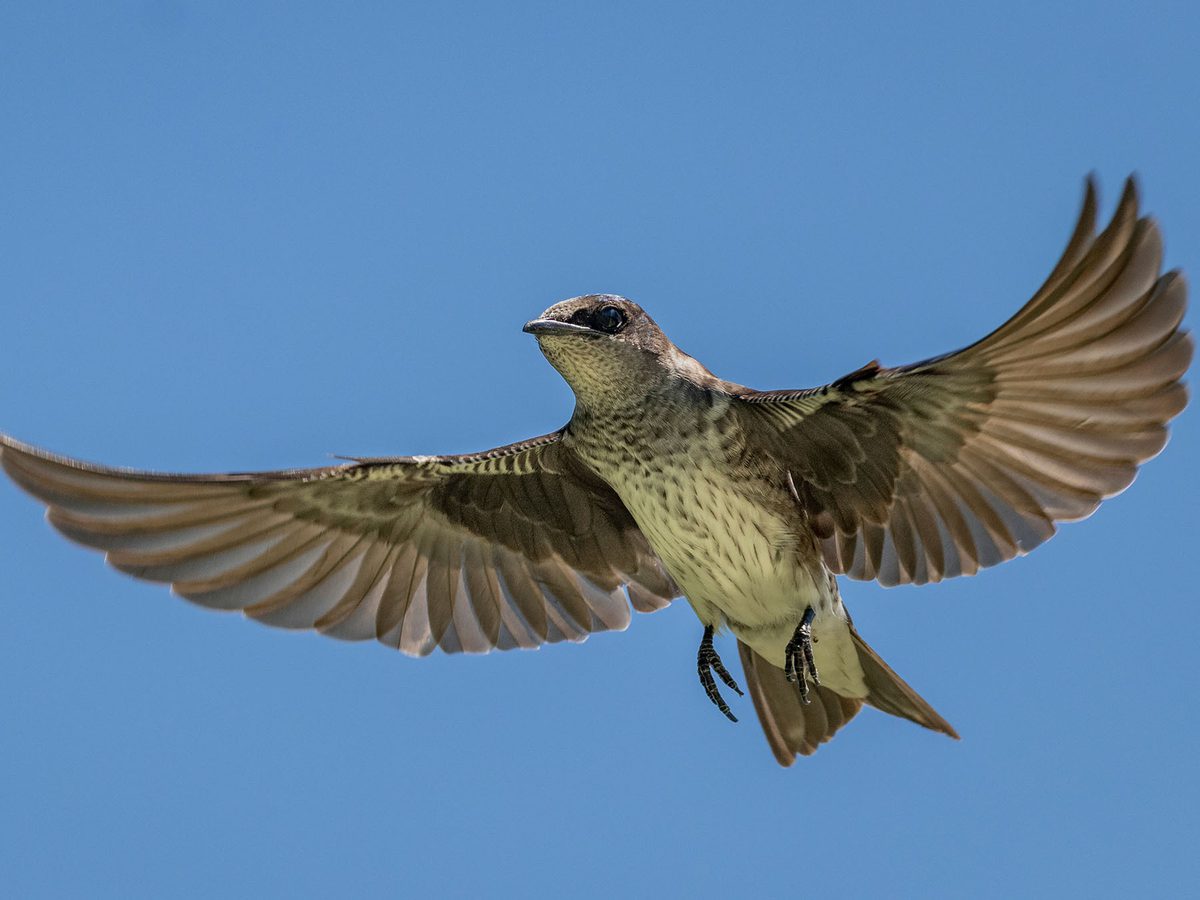Purple martins are a much-loved member of the Hirundinidae swallow family. Male Purple martins live up to their namesake with a beautiful blue-black sheen that looks purple in certain light.
A migratory bird, Purple martins live across the US and Canada and migrate south to Central and South America. This is a guide to Purple martin migration.
The vast majority of Purple martins migrate across the southern and southeastern United States across Mexico to South America, where they winter in Peru, Bolivia, and Brazil.
Purple martins form colossal flocks in late summer - some are so large that they appear on weather sensors!
Purple martins travel long distances every day, up to 350 miles per day in some cases. Migration starts pretty early in late August to early September, and wintering doesn’t last long, with many birds returning to the southern states in late December and January.
Of course, there’s much more to learn about Purple martin migration - read on to find out more!

Purple Martins are highly migratory
Do Purple Martins migrate?
Purple martins are strongly migratory; many travel thousands of miles from Canada and the US to Brazil, Peru, and Bolivia.
Purple Martins are most abundant in the east USA, where they migrate across the Gulf of Mexico, but those that breed further west probably fly across Mexico and Central America.
En route from their breeding grounds, Purple martins form huge flocks on the Gulf Coast, which act as a staging ground for the final leg of the journey.
These late summer roosts grow extremely large with hundreds of thousands of birds. They’re so large that they’re picked up as weather activity on meteorological sensors like Doppler radar.
The vast majority of Purple swallows winter in the Amazon Basin, which primarily consists of Brazil, Bolivia, and Peru.

Purple Martin migration can be thousands of miles
When do Purple Martins migrate?
In fall, at the end of the breeding season, Purple martins gather for migration from as early as July to as late as October.
Birds further north generally leave sooner, with some exceptions. For example, one study in Pennsylvania traced two female Purple Martins who left in late August, reaching Honduras after a few days and Brazil on the 10th to 13th of October.
In the southern US, Purple swallows leave in mid-October, though some linger around the Gulf Coast until November.
Very few birds reach their wintering grounds before September, with peak arrivals occurring from late September to early October.
Why do Purple Martins migrate?
Purple martins migrate to pursue warmer weather which brings about abundant food sources. In addition, the longer days and milder weather make life easier after a long, tough breeding season.
In essence, migratory birds are on vacation from the breeding season - it’s advantageous for them to travel south rather than brave winter in their breeding grounds.

Close up of a female Purple Martin in flight
How far do Purple Martins migrate?
Purple martins are long-distance migrants that travel over 5,000 miles from the upper parts of their range to the Amazon Basin.
They can cover distances of some 350 miles per day, which would involve maintaining a steady speed of 25mph or so for 20 hours.
How long is Purple Martin migration?
Most Purple Martin migratory journeys from the northern US and Canada take over a month or two to complete.
For example, one banded bird in Oregon left its breeding grounds in late August and didn’t reach Arizona until November - a total of 110 days. Another bird in Texas reached Colombia after 65 days.
Researchers believe some Purple martins migrate slowly and leisurely, whereas others tend to put the pedal to the metal and get to their wintering grounds as soon as possible.

Perched Purple Martin with an insect in its beak
Where do Purple Martins migrate to?
Purple martins head across the Gulf of Mexico and Central America to the Amazon Basin, which primarily consists of Brazil, Peru, and Bolivia. They’re also found in Colombia, Venezuela, Ecuador, Paraguay, north Argentina, British Guyana, Suriname, and French Guiana.
Do Purple Martins fly nonstop?
Purple martins cover significant distances every day. In one study, Purple martins traveled around 350 miles per day without stopping, meaning they maintain speeds of around 25 to 35mph for around 10 to 15 hours per day.
However, most Purple martins make several stops along the way. For example, those traveling across the Gulf of Mexico stop to rejuvenate along the Gulf Coast, whereas those traveling overland stop throughout Central America.

Male nesting Purple Martin perched outside of his nest box
Do Purple Martins migrate in flocks?
From late summer to early fall, Purple martins become increasingly sociable and gather in colossal roosts.
These pre-migration roosts form in the Gulf states and number hundreds of thousands of birds. Once they’re assembled, martins migration is staggered with smaller flocks leaving at different times.
Are all Purple Martins migratory?
All Purple martins migrate. This is true of both adult and juvenile birds.
While some stray birds linger in North America until November or so, practically all Purple martins leave the continent entirely, heading to Central and South America to return in late winter or early spring.

Close up of a Purple Martin male in flight
Where do Purple Martins go in winter?
Purple martins head south towards South America in the fall. The vast majority spend winter in the Amazon Basin, which mainly consists of Brazil, Bolivia, and Peru.
Others stay in Colombia, Venezuela, Ecuador, Paraguay, north Argentina, British Guyana, Suriname, and French Guiana.
Interestingly, Purple martins aren’t too concerned about heading to the same wintering sites each year. This is because wintering sites vary by hundreds of miles, and the same birds likely head to different regions every year.
Where do Purple Martins go in the summer?
Purple martins occupy their northern breeding grounds in summer, which consist primarily of the eastern and northern USA and southern Canada.
They also occupy much of the southern and southeastern states and parts of the southwest and Pacific coast up to Oregon.
